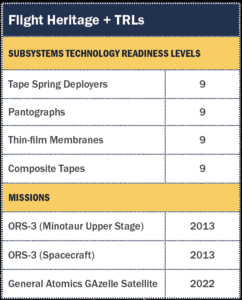Case Study: De-Orbit
dragNET De-orbit System
Players: MMA Design, AFRL
The Challenge
Tens of thousands of man-made pieces of debris are currently buzzing around us in a low-Earth orbit (LEO, which includes anything below 2,000 kilometers altitude). Fragments spawned by the collision of those pieces, along with an ever-increasing rate of launch for new satellites and spacecraft, have created a growing field of space debris that poses a significant risk to critical communications — think Internet, cell phones, and space comms, as well as banking systems, military surveillance operations and, in the near future, manned space flight.
Recently, de-orbiting spacecraft and launch vehicle upper stages have become a high priority consideration for missions in the wake of a new Federal Communications Commission (FCC) ruling which requires satellites ending their mission in, or passing through, LEO to deorbit as soon as reasonably feasible but no later than five years after its mission is complete. This new rule significantly shortens the previous guideline set forth by NASA in the 90s which recommended that satellites de-orbit within 25-years, or else move into a graveyard orbit for safe storage.

* Legacy dragNET
** Assumes sail is normal to orbital path.
While this new rule allows missions 2 years to transition to the new reality, it comes as the FCC strives to modernize its regulations to match the requirements of a changing public and private New Space sector.
The Solution
In 2013, with funding from an Air Force SBIR, MMA developed and successfully demonstrated a system to remove satellites from orbit (reference Norad ID 39409 for deorbit history), the dragNET De-orbit System. dragNET is a bolt-on solution that can feasibly be added to an existing space asset, such as a spacecraft or launch-vehicle body, late in the integration stage.

The dragNET De-orbit System consists of compactly stowed, thin membranes that package in a volume the size of a shoebox and release using a single heater-powered actuator. Deployment is powered by releasing stored spring energy acting through articulating booms, and once tensioned, the deployed sails create the drag necessary to passively deorbit the space asset. Although it only weighs just over two kilograms, it is estimated that the system can bring down a 160-kg space asset from an altitude of 700 km in less than 5 years.

dragNET shown stowed on General Atomics’ GAzelle Satellite at RocketLab’s facility.
Photo courtesy of Rocket Lab.

dragNET shown stowed on STPSat-3 satellite during final integration.

dragNET De-Orbit System shown fully deployed.
The Results
In 2013, a 14m2 dragNET successfully deorbited the upper stage of the ORS-3 Minotaur in about 2 years. Since that first successful flight demonstration, other components and subsystems used on the dragNET have been flight tested on various MMA solutions, from solar arrays and antennas to space optics. So, our focus has turned to applying our learnings and improvements to support deorbiting larger spacecraft from higher altitudes. Like everything we do, dragNET was designed with reliability and scalability in mind so that our technology solutions can support your mission with high confidence no matter what form factor.





